Economics Assignment: Innovation, Governance, and Economic Development
VerifiedAdded on 2023/01/07
|11
|2607
|28
Homework Assignment
AI Summary
This economics assignment delves into various aspects of economic theory and practice. It begins by differentiating between innovation and invention, exploring different types of innovation, and describing innovation as a linear process within formal mathematical models. The assignment then defines technological and social capabilities, ranks factors crucial for economic development, and emphasizes the importance of the education system. Further, it examines multinational corporations (MNCs), strategies for partnering with them, and steps to compete against them, along with government policies for facilitating a favorable environment for MNCs. Finally, the assignment analyzes different governance structures, including market-based, modular, relational, captive, and hierarchical governance, highlighting their characteristics and advantages.
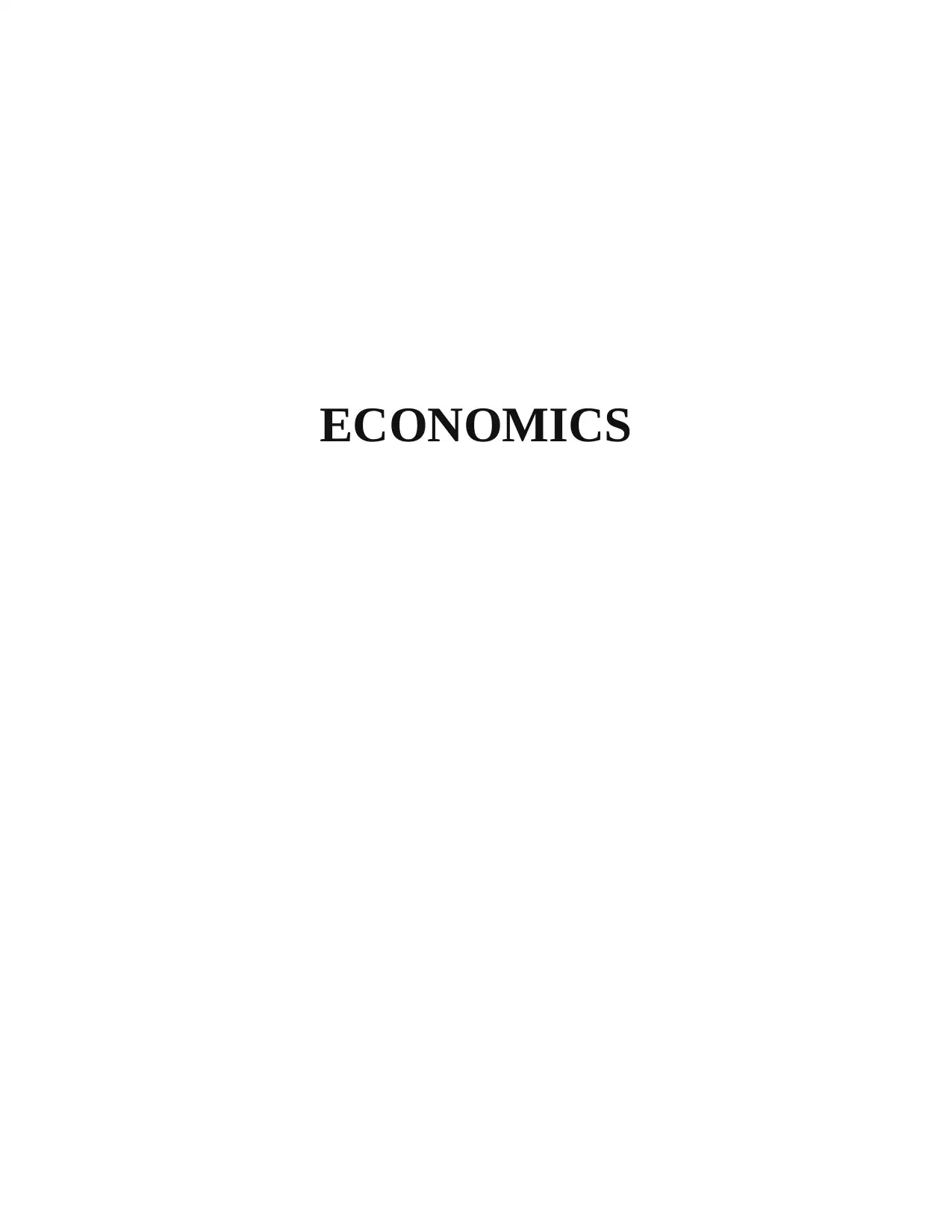
ECONOMICS
Paraphrase This Document
Need a fresh take? Get an instant paraphrase of this document with our AI Paraphraser
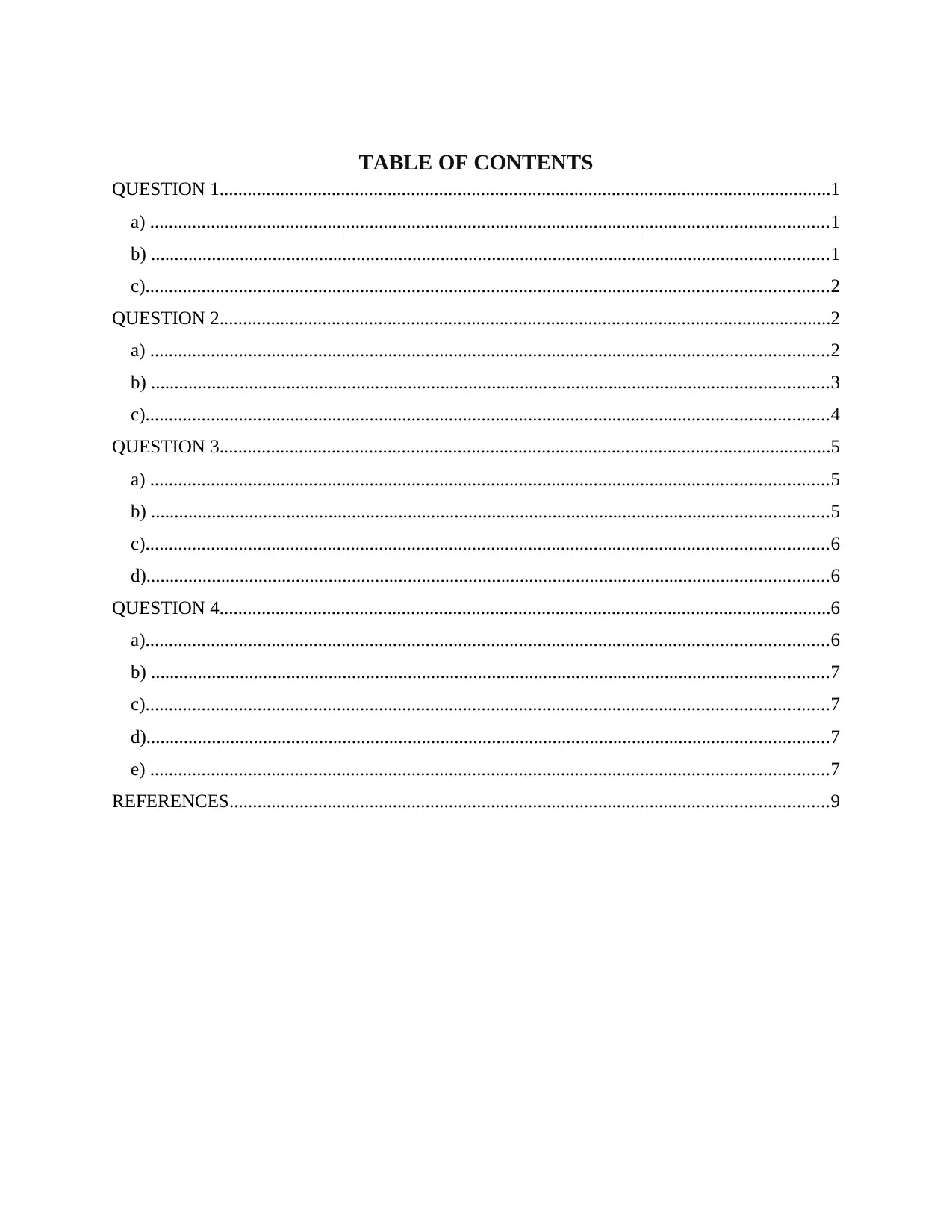
TABLE OF CONTENTS
QUESTION 1...................................................................................................................................1
a) .................................................................................................................................................1
b) .................................................................................................................................................1
c)..................................................................................................................................................2
QUESTION 2...................................................................................................................................2
a) .................................................................................................................................................2
b) .................................................................................................................................................3
c)..................................................................................................................................................4
QUESTION 3...................................................................................................................................5
a) .................................................................................................................................................5
b) .................................................................................................................................................5
c)..................................................................................................................................................6
d)..................................................................................................................................................6
QUESTION 4...................................................................................................................................6
a)..................................................................................................................................................6
b) .................................................................................................................................................7
c)..................................................................................................................................................7
d)..................................................................................................................................................7
e) .................................................................................................................................................7
REFERENCES................................................................................................................................9
QUESTION 1...................................................................................................................................1
a) .................................................................................................................................................1
b) .................................................................................................................................................1
c)..................................................................................................................................................2
QUESTION 2...................................................................................................................................2
a) .................................................................................................................................................2
b) .................................................................................................................................................3
c)..................................................................................................................................................4
QUESTION 3...................................................................................................................................5
a) .................................................................................................................................................5
b) .................................................................................................................................................5
c)..................................................................................................................................................6
d)..................................................................................................................................................6
QUESTION 4...................................................................................................................................6
a)..................................................................................................................................................6
b) .................................................................................................................................................7
c)..................................................................................................................................................7
d)..................................................................................................................................................7
e) .................................................................................................................................................7
REFERENCES................................................................................................................................9

QUESTION 1
a)
Difference between innovation and invention
Invention could be described as creation of products or the introduction of process for
first time. On the other innovation occurs when someone makes improvements or make
significant contribution to the existing process, product or service.
Invention includes physical creation of the new idea or concept. Examples of invention
are business models, product designs or the working prototypes. Innovation ties the business
together with the business. It refers to successful exploitation of the new ideas and also involves
turning the invention into commercial success and the encouragement of widespread use.
Example :process innovation or additive manufacturing process.
b)
Different types of innovation usually identified by the economic and business studies
There are different types of innovations in economic and business studies.
Economic innovations
Incremental Innovation
It includes utilisation of the existing technology and increase in value to customers within
the existing market.
Disruptive Innovation
This type of innovation involves application of new technology or the processes to the
current market of company (Cinnirella and Streb, 2017). New technology is generally expensive
and have fewer features, hard to use and not pleasing.
Architectural Innovation
It involves taking lessons skills and the overall technology and application within
different market. Risk is low because of reintroduction and reliance of the proven technology.
Business innovations
Organisational innovations
It refers to development of the new organisational strategy which will change the
business practices of the company.
Process innovations
1
a)
Difference between innovation and invention
Invention could be described as creation of products or the introduction of process for
first time. On the other innovation occurs when someone makes improvements or make
significant contribution to the existing process, product or service.
Invention includes physical creation of the new idea or concept. Examples of invention
are business models, product designs or the working prototypes. Innovation ties the business
together with the business. It refers to successful exploitation of the new ideas and also involves
turning the invention into commercial success and the encouragement of widespread use.
Example :process innovation or additive manufacturing process.
b)
Different types of innovation usually identified by the economic and business studies
There are different types of innovations in economic and business studies.
Economic innovations
Incremental Innovation
It includes utilisation of the existing technology and increase in value to customers within
the existing market.
Disruptive Innovation
This type of innovation involves application of new technology or the processes to the
current market of company (Cinnirella and Streb, 2017). New technology is generally expensive
and have fewer features, hard to use and not pleasing.
Architectural Innovation
It involves taking lessons skills and the overall technology and application within
different market. Risk is low because of reintroduction and reliance of the proven technology.
Business innovations
Organisational innovations
It refers to development of the new organisational strategy which will change the
business practices of the company.
Process innovations
1
⊘ This is a preview!⊘
Do you want full access?
Subscribe today to unlock all pages.

Trusted by 1+ million students worldwide
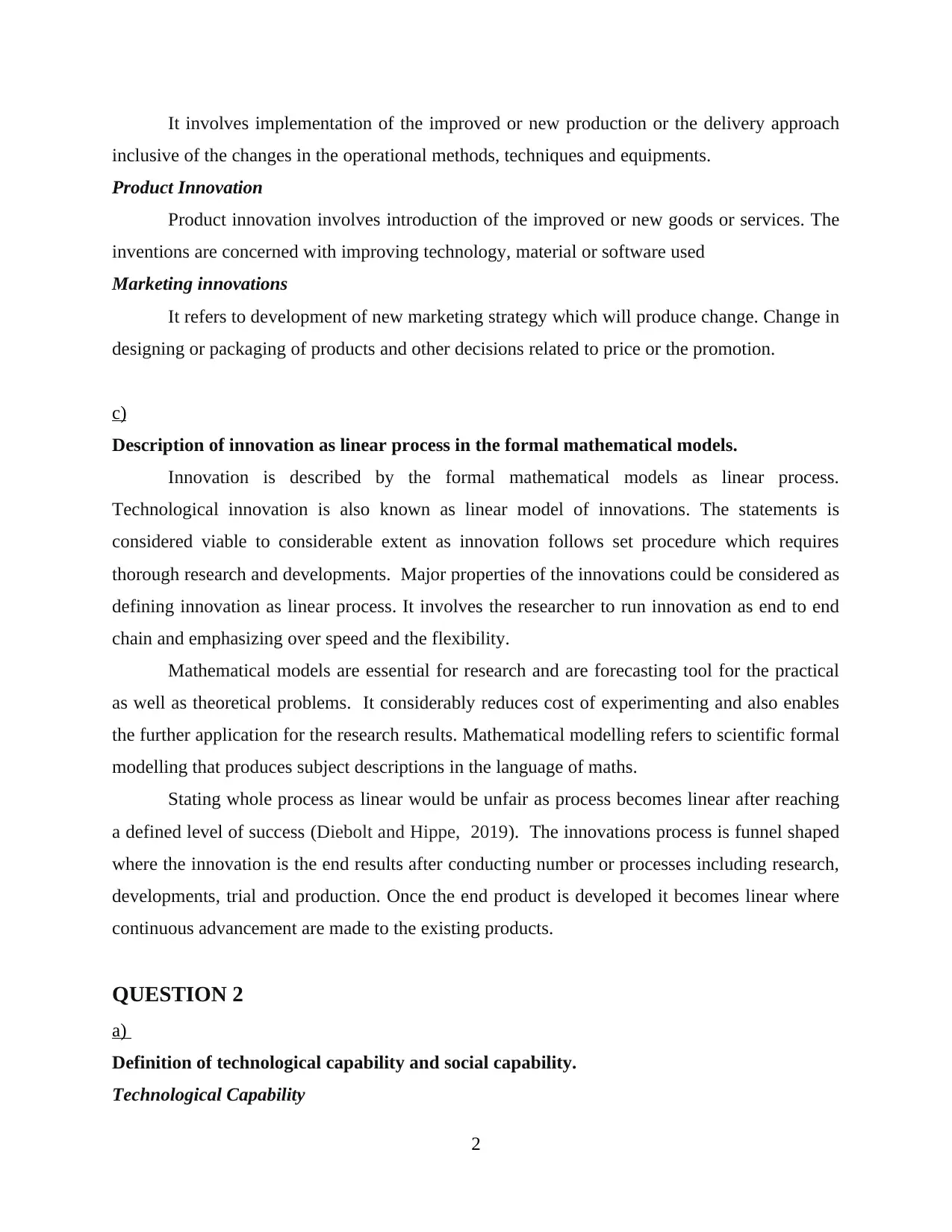
It involves implementation of the improved or new production or the delivery approach
inclusive of the changes in the operational methods, techniques and equipments.
Product Innovation
Product innovation involves introduction of the improved or new goods or services. The
inventions are concerned with improving technology, material or software used
Marketing innovations
It refers to development of new marketing strategy which will produce change. Change in
designing or packaging of products and other decisions related to price or the promotion.
c)
Description of innovation as linear process in the formal mathematical models.
Innovation is described by the formal mathematical models as linear process.
Technological innovation is also known as linear model of innovations. The statements is
considered viable to considerable extent as innovation follows set procedure which requires
thorough research and developments. Major properties of the innovations could be considered as
defining innovation as linear process. It involves the researcher to run innovation as end to end
chain and emphasizing over speed and the flexibility.
Mathematical models are essential for research and are forecasting tool for the practical
as well as theoretical problems. It considerably reduces cost of experimenting and also enables
the further application for the research results. Mathematical modelling refers to scientific formal
modelling that produces subject descriptions in the language of maths.
Stating whole process as linear would be unfair as process becomes linear after reaching
a defined level of success (Diebolt and Hippe, 2019). The innovations process is funnel shaped
where the innovation is the end results after conducting number or processes including research,
developments, trial and production. Once the end product is developed it becomes linear where
continuous advancement are made to the existing products.
QUESTION 2
a)
Definition of technological capability and social capability.
Technological Capability
2
inclusive of the changes in the operational methods, techniques and equipments.
Product Innovation
Product innovation involves introduction of the improved or new goods or services. The
inventions are concerned with improving technology, material or software used
Marketing innovations
It refers to development of new marketing strategy which will produce change. Change in
designing or packaging of products and other decisions related to price or the promotion.
c)
Description of innovation as linear process in the formal mathematical models.
Innovation is described by the formal mathematical models as linear process.
Technological innovation is also known as linear model of innovations. The statements is
considered viable to considerable extent as innovation follows set procedure which requires
thorough research and developments. Major properties of the innovations could be considered as
defining innovation as linear process. It involves the researcher to run innovation as end to end
chain and emphasizing over speed and the flexibility.
Mathematical models are essential for research and are forecasting tool for the practical
as well as theoretical problems. It considerably reduces cost of experimenting and also enables
the further application for the research results. Mathematical modelling refers to scientific formal
modelling that produces subject descriptions in the language of maths.
Stating whole process as linear would be unfair as process becomes linear after reaching
a defined level of success (Diebolt and Hippe, 2019). The innovations process is funnel shaped
where the innovation is the end results after conducting number or processes including research,
developments, trial and production. Once the end product is developed it becomes linear where
continuous advancement are made to the existing products.
QUESTION 2
a)
Definition of technological capability and social capability.
Technological Capability
2
Paraphrase This Document
Need a fresh take? Get an instant paraphrase of this document with our AI Paraphraser
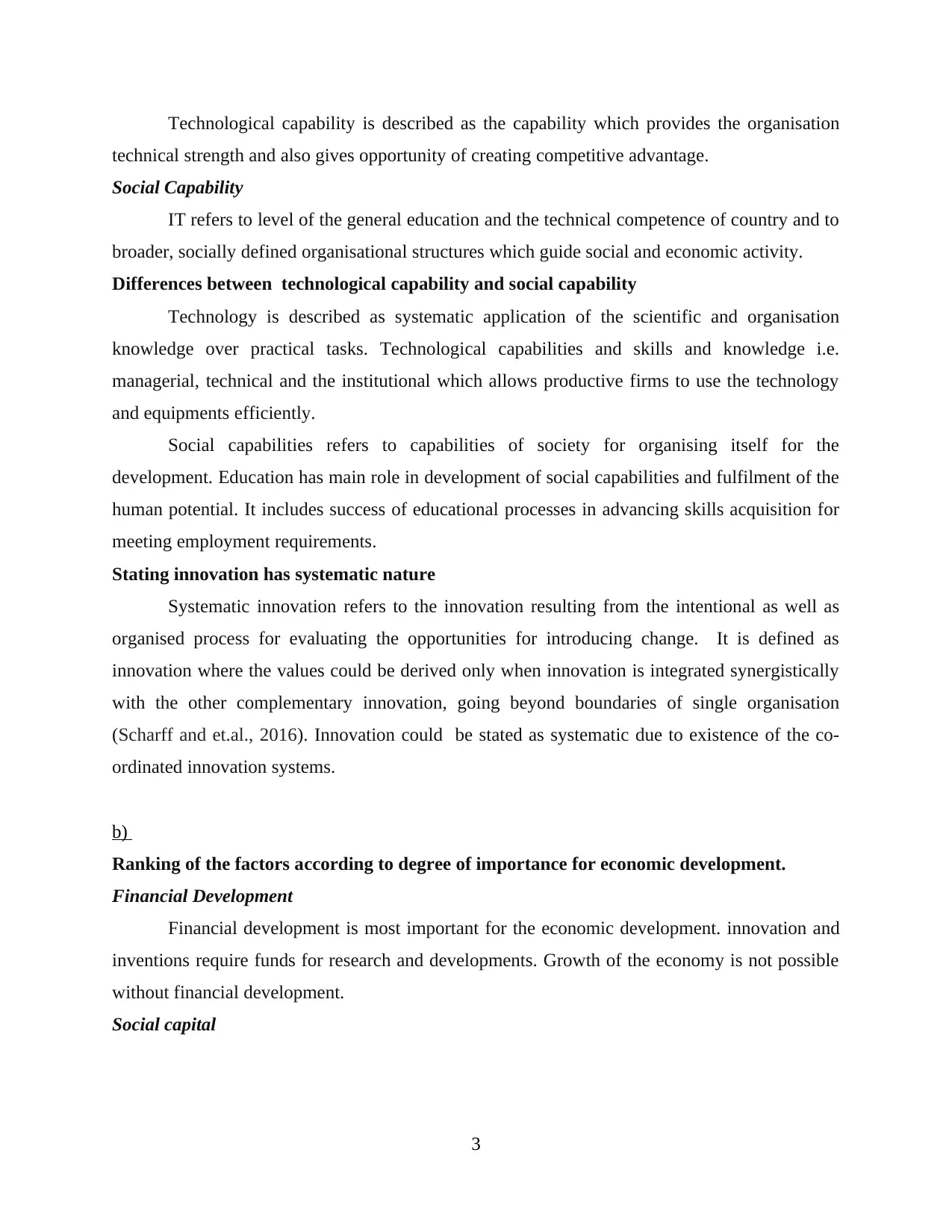
Technological capability is described as the capability which provides the organisation
technical strength and also gives opportunity of creating competitive advantage.
Social Capability
IT refers to level of the general education and the technical competence of country and to
broader, socially defined organisational structures which guide social and economic activity.
Differences between technological capability and social capability
Technology is described as systematic application of the scientific and organisation
knowledge over practical tasks. Technological capabilities and skills and knowledge i.e.
managerial, technical and the institutional which allows productive firms to use the technology
and equipments efficiently.
Social capabilities refers to capabilities of society for organising itself for the
development. Education has main role in development of social capabilities and fulfilment of the
human potential. It includes success of educational processes in advancing skills acquisition for
meeting employment requirements.
Stating innovation has systematic nature
Systematic innovation refers to the innovation resulting from the intentional as well as
organised process for evaluating the opportunities for introducing change. It is defined as
innovation where the values could be derived only when innovation is integrated synergistically
with the other complementary innovation, going beyond boundaries of single organisation
(Scharff and et.al., 2016). Innovation could be stated as systematic due to existence of the co-
ordinated innovation systems.
b)
Ranking of the factors according to degree of importance for economic development.
Financial Development
Financial development is most important for the economic development. innovation and
inventions require funds for research and developments. Growth of the economy is not possible
without financial development.
Social capital
3
technical strength and also gives opportunity of creating competitive advantage.
Social Capability
IT refers to level of the general education and the technical competence of country and to
broader, socially defined organisational structures which guide social and economic activity.
Differences between technological capability and social capability
Technology is described as systematic application of the scientific and organisation
knowledge over practical tasks. Technological capabilities and skills and knowledge i.e.
managerial, technical and the institutional which allows productive firms to use the technology
and equipments efficiently.
Social capabilities refers to capabilities of society for organising itself for the
development. Education has main role in development of social capabilities and fulfilment of the
human potential. It includes success of educational processes in advancing skills acquisition for
meeting employment requirements.
Stating innovation has systematic nature
Systematic innovation refers to the innovation resulting from the intentional as well as
organised process for evaluating the opportunities for introducing change. It is defined as
innovation where the values could be derived only when innovation is integrated synergistically
with the other complementary innovation, going beyond boundaries of single organisation
(Scharff and et.al., 2016). Innovation could be stated as systematic due to existence of the co-
ordinated innovation systems.
b)
Ranking of the factors according to degree of importance for economic development.
Financial Development
Financial development is most important for the economic development. innovation and
inventions require funds for research and developments. Growth of the economy is not possible
without financial development.
Social capital
3
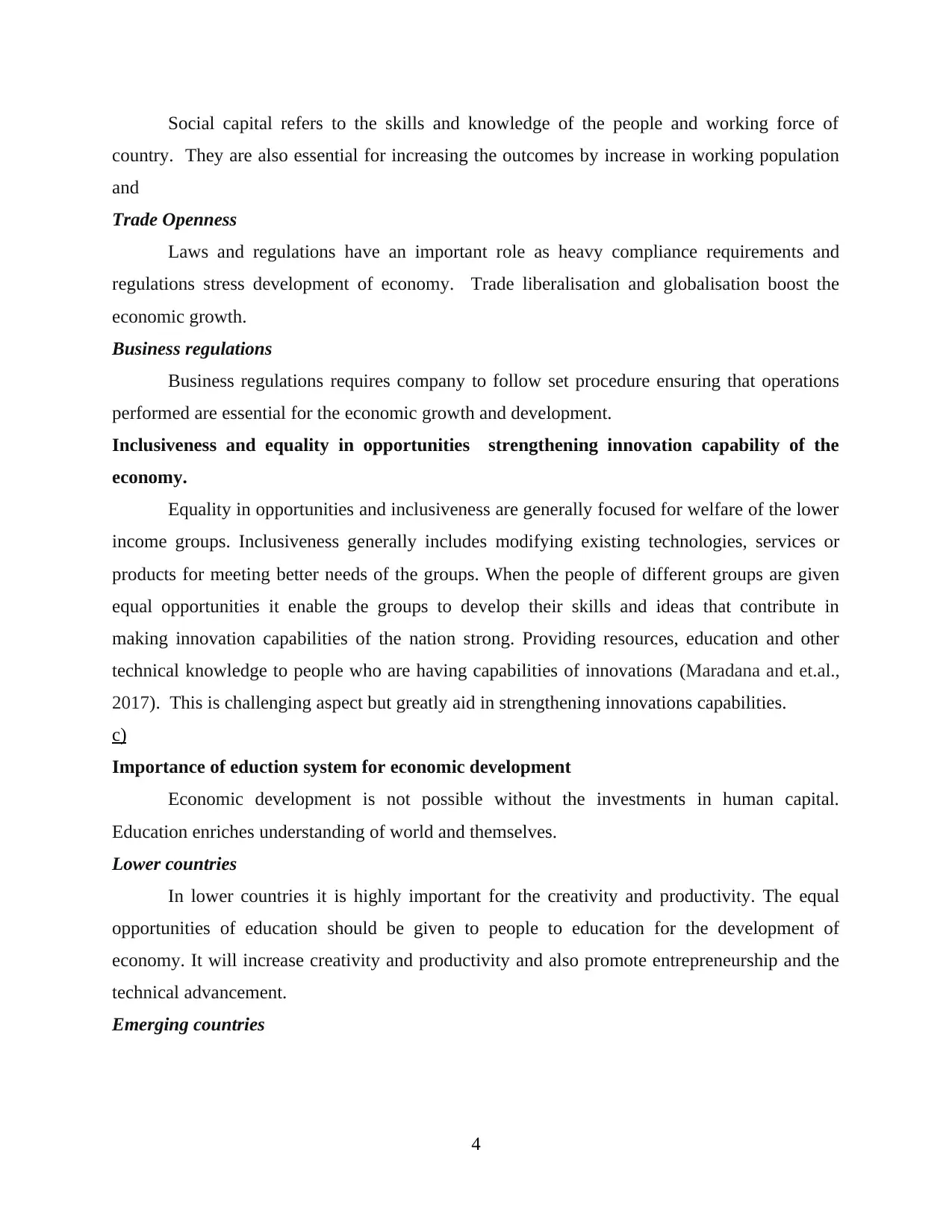
Social capital refers to the skills and knowledge of the people and working force of
country. They are also essential for increasing the outcomes by increase in working population
and
Trade Openness
Laws and regulations have an important role as heavy compliance requirements and
regulations stress development of economy. Trade liberalisation and globalisation boost the
economic growth.
Business regulations
Business regulations requires company to follow set procedure ensuring that operations
performed are essential for the economic growth and development.
Inclusiveness and equality in opportunities strengthening innovation capability of the
economy.
Equality in opportunities and inclusiveness are generally focused for welfare of the lower
income groups. Inclusiveness generally includes modifying existing technologies, services or
products for meeting better needs of the groups. When the people of different groups are given
equal opportunities it enable the groups to develop their skills and ideas that contribute in
making innovation capabilities of the nation strong. Providing resources, education and other
technical knowledge to people who are having capabilities of innovations (Maradana and et.al.,
2017). This is challenging aspect but greatly aid in strengthening innovations capabilities.
c)
Importance of eduction system for economic development
Economic development is not possible without the investments in human capital.
Education enriches understanding of world and themselves.
Lower countries
In lower countries it is highly important for the creativity and productivity. The equal
opportunities of education should be given to people to education for the development of
economy. It will increase creativity and productivity and also promote entrepreneurship and the
technical advancement.
Emerging countries
4
country. They are also essential for increasing the outcomes by increase in working population
and
Trade Openness
Laws and regulations have an important role as heavy compliance requirements and
regulations stress development of economy. Trade liberalisation and globalisation boost the
economic growth.
Business regulations
Business regulations requires company to follow set procedure ensuring that operations
performed are essential for the economic growth and development.
Inclusiveness and equality in opportunities strengthening innovation capability of the
economy.
Equality in opportunities and inclusiveness are generally focused for welfare of the lower
income groups. Inclusiveness generally includes modifying existing technologies, services or
products for meeting better needs of the groups. When the people of different groups are given
equal opportunities it enable the groups to develop their skills and ideas that contribute in
making innovation capabilities of the nation strong. Providing resources, education and other
technical knowledge to people who are having capabilities of innovations (Maradana and et.al.,
2017). This is challenging aspect but greatly aid in strengthening innovations capabilities.
c)
Importance of eduction system for economic development
Economic development is not possible without the investments in human capital.
Education enriches understanding of world and themselves.
Lower countries
In lower countries it is highly important for the creativity and productivity. The equal
opportunities of education should be given to people to education for the development of
economy. It will increase creativity and productivity and also promote entrepreneurship and the
technical advancement.
Emerging countries
4
⊘ This is a preview!⊘
Do you want full access?
Subscribe today to unlock all pages.

Trusted by 1+ million students worldwide
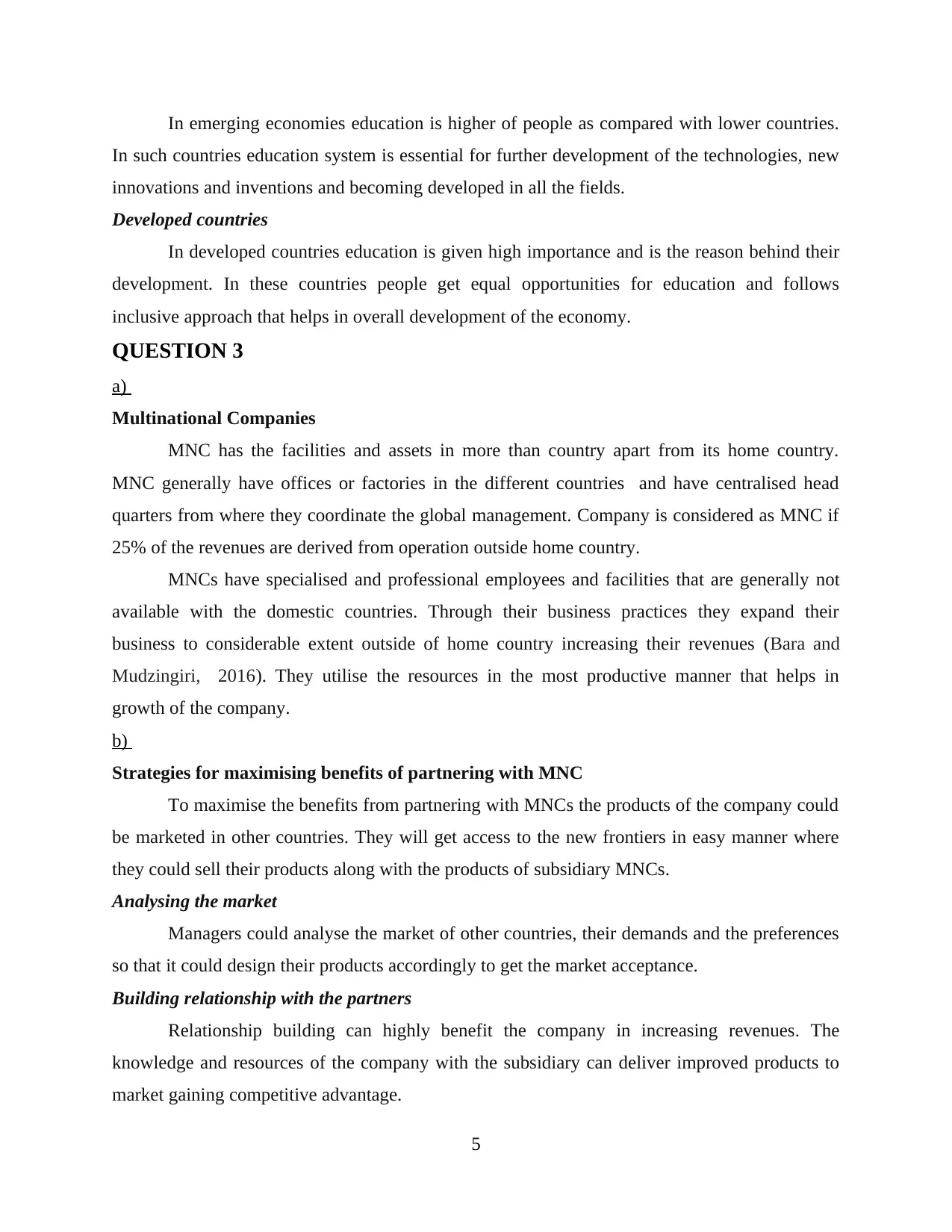
In emerging economies education is higher of people as compared with lower countries.
In such countries education system is essential for further development of the technologies, new
innovations and inventions and becoming developed in all the fields.
Developed countries
In developed countries education is given high importance and is the reason behind their
development. In these countries people get equal opportunities for education and follows
inclusive approach that helps in overall development of the economy.
QUESTION 3
a)
Multinational Companies
MNC has the facilities and assets in more than country apart from its home country.
MNC generally have offices or factories in the different countries and have centralised head
quarters from where they coordinate the global management. Company is considered as MNC if
25% of the revenues are derived from operation outside home country.
MNCs have specialised and professional employees and facilities that are generally not
available with the domestic countries. Through their business practices they expand their
business to considerable extent outside of home country increasing their revenues (Bara and
Mudzingiri, 2016). They utilise the resources in the most productive manner that helps in
growth of the company.
b)
Strategies for maximising benefits of partnering with MNC
To maximise the benefits from partnering with MNCs the products of the company could
be marketed in other countries. They will get access to the new frontiers in easy manner where
they could sell their products along with the products of subsidiary MNCs.
Analysing the market
Managers could analyse the market of other countries, their demands and the preferences
so that it could design their products accordingly to get the market acceptance.
Building relationship with the partners
Relationship building can highly benefit the company in increasing revenues. The
knowledge and resources of the company with the subsidiary can deliver improved products to
market gaining competitive advantage.
5
In such countries education system is essential for further development of the technologies, new
innovations and inventions and becoming developed in all the fields.
Developed countries
In developed countries education is given high importance and is the reason behind their
development. In these countries people get equal opportunities for education and follows
inclusive approach that helps in overall development of the economy.
QUESTION 3
a)
Multinational Companies
MNC has the facilities and assets in more than country apart from its home country.
MNC generally have offices or factories in the different countries and have centralised head
quarters from where they coordinate the global management. Company is considered as MNC if
25% of the revenues are derived from operation outside home country.
MNCs have specialised and professional employees and facilities that are generally not
available with the domestic countries. Through their business practices they expand their
business to considerable extent outside of home country increasing their revenues (Bara and
Mudzingiri, 2016). They utilise the resources in the most productive manner that helps in
growth of the company.
b)
Strategies for maximising benefits of partnering with MNC
To maximise the benefits from partnering with MNCs the products of the company could
be marketed in other countries. They will get access to the new frontiers in easy manner where
they could sell their products along with the products of subsidiary MNCs.
Analysing the market
Managers could analyse the market of other countries, their demands and the preferences
so that it could design their products accordingly to get the market acceptance.
Building relationship with the partners
Relationship building can highly benefit the company in increasing revenues. The
knowledge and resources of the company with the subsidiary can deliver improved products to
market gaining competitive advantage.
5
Paraphrase This Document
Need a fresh take? Get an instant paraphrase of this document with our AI Paraphraser
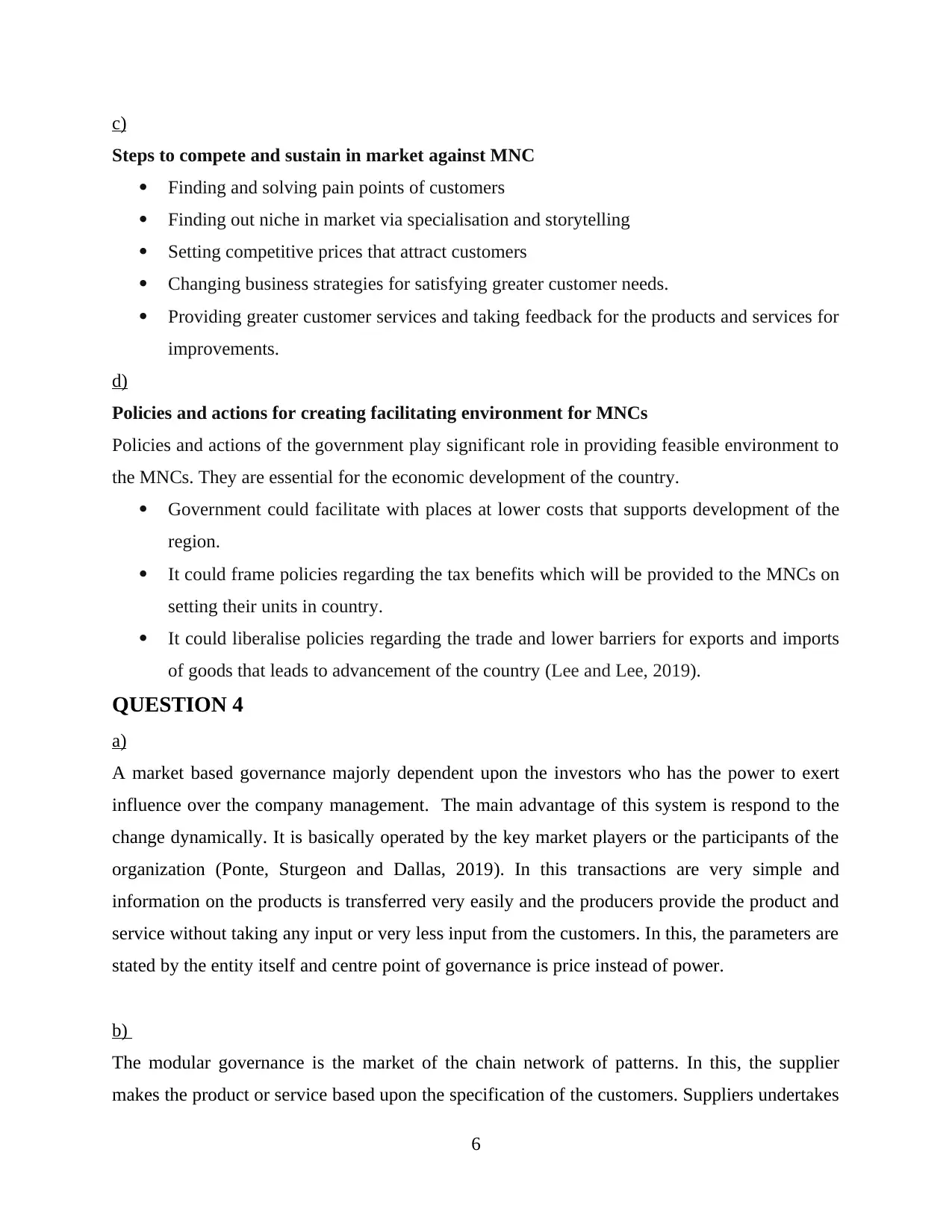
c)
Steps to compete and sustain in market against MNC
Finding and solving pain points of customers
Finding out niche in market via specialisation and storytelling
Setting competitive prices that attract customers
Changing business strategies for satisfying greater customer needs.
Providing greater customer services and taking feedback for the products and services for
improvements.
d)
Policies and actions for creating facilitating environment for MNCs
Policies and actions of the government play significant role in providing feasible environment to
the MNCs. They are essential for the economic development of the country.
Government could facilitate with places at lower costs that supports development of the
region.
It could frame policies regarding the tax benefits which will be provided to the MNCs on
setting their units in country.
It could liberalise policies regarding the trade and lower barriers for exports and imports
of goods that leads to advancement of the country (Lee and Lee, 2019).
QUESTION 4
a)
A market based governance majorly dependent upon the investors who has the power to exert
influence over the company management. The main advantage of this system is respond to the
change dynamically. It is basically operated by the key market players or the participants of the
organization (Ponte, Sturgeon and Dallas, 2019). In this transactions are very simple and
information on the products is transferred very easily and the producers provide the product and
service without taking any input or very less input from the customers. In this, the parameters are
stated by the entity itself and centre point of governance is price instead of power.
b)
The modular governance is the market of the chain network of patterns. In this, the supplier
makes the product or service based upon the specification of the customers. Suppliers undertakes
6
Steps to compete and sustain in market against MNC
Finding and solving pain points of customers
Finding out niche in market via specialisation and storytelling
Setting competitive prices that attract customers
Changing business strategies for satisfying greater customer needs.
Providing greater customer services and taking feedback for the products and services for
improvements.
d)
Policies and actions for creating facilitating environment for MNCs
Policies and actions of the government play significant role in providing feasible environment to
the MNCs. They are essential for the economic development of the country.
Government could facilitate with places at lower costs that supports development of the
region.
It could frame policies regarding the tax benefits which will be provided to the MNCs on
setting their units in country.
It could liberalise policies regarding the trade and lower barriers for exports and imports
of goods that leads to advancement of the country (Lee and Lee, 2019).
QUESTION 4
a)
A market based governance majorly dependent upon the investors who has the power to exert
influence over the company management. The main advantage of this system is respond to the
change dynamically. It is basically operated by the key market players or the participants of the
organization (Ponte, Sturgeon and Dallas, 2019). In this transactions are very simple and
information on the products is transferred very easily and the producers provide the product and
service without taking any input or very less input from the customers. In this, the parameters are
stated by the entity itself and centre point of governance is price instead of power.
b)
The modular governance is the market of the chain network of patterns. In this, the supplier
makes the product or service based upon the specification of the customers. Suppliers undertakes
6

the responsibility for processing of technology and spreading investment across the customer
base. It keeps the switching cost at very low and also puts limits on the transactions which si
specific to investment. It is considered superior than market based because in modular the
products are made or the services are being provided using the customer specification which is
not so in case of market based governance.
c)
In relational style, the interaction among the customers and the providers are characterized on
account of the transmission of data and embedded services which is completely based upon the
reputation. Social and the ethnic ties. This is considered superior than other style because even
though the lead firm is dependent but then too it specifies what it requires and also exercises
control over the highest valuable activities (Gereffi and Lee, 2016). Therefore, having the ability
to exercise more power over the suppliers. This results into dense interaction and knowledge
sharing and unlike modular, style, in this knowledge and information is not codified.
d)
In captive type, the small scale suppliers are mainly dependent upon the very few purchasers
which are having power and control. There is a asymmetric power relationship in this style,
which forces the suppliers for linking with their buyers under the criteria which were set
(Mosmann and Klutt, 2020). The core competence of the firm excludes the production
capabilities. The technology can be transferred by enhancing the efficiency level of supply
chain. In such case, high level of competency, and leadership is essential in order to ensure that
the suppliers gets the fair and equitable share.
e)
The hierarchical governance defines the chains which is defined as the vertical integration and
also has the managerial control inside the limits set by the firms that helps in developing and
manufacturing product in-house. This structure provides the consistent employment and also
helps in building the producer capacity. Under hierarchical governance, there are less social
benefits but the influential people in the entity might offer protection to the local institutions
such as health facilities. These advantages or the benefits are considered very crucial for the
7
base. It keeps the switching cost at very low and also puts limits on the transactions which si
specific to investment. It is considered superior than market based because in modular the
products are made or the services are being provided using the customer specification which is
not so in case of market based governance.
c)
In relational style, the interaction among the customers and the providers are characterized on
account of the transmission of data and embedded services which is completely based upon the
reputation. Social and the ethnic ties. This is considered superior than other style because even
though the lead firm is dependent but then too it specifies what it requires and also exercises
control over the highest valuable activities (Gereffi and Lee, 2016). Therefore, having the ability
to exercise more power over the suppliers. This results into dense interaction and knowledge
sharing and unlike modular, style, in this knowledge and information is not codified.
d)
In captive type, the small scale suppliers are mainly dependent upon the very few purchasers
which are having power and control. There is a asymmetric power relationship in this style,
which forces the suppliers for linking with their buyers under the criteria which were set
(Mosmann and Klutt, 2020). The core competence of the firm excludes the production
capabilities. The technology can be transferred by enhancing the efficiency level of supply
chain. In such case, high level of competency, and leadership is essential in order to ensure that
the suppliers gets the fair and equitable share.
e)
The hierarchical governance defines the chains which is defined as the vertical integration and
also has the managerial control inside the limits set by the firms that helps in developing and
manufacturing product in-house. This structure provides the consistent employment and also
helps in building the producer capacity. Under hierarchical governance, there are less social
benefits but the influential people in the entity might offer protection to the local institutions
such as health facilities. These advantages or the benefits are considered very crucial for the
7
⊘ This is a preview!⊘
Do you want full access?
Subscribe today to unlock all pages.

Trusted by 1+ million students worldwide
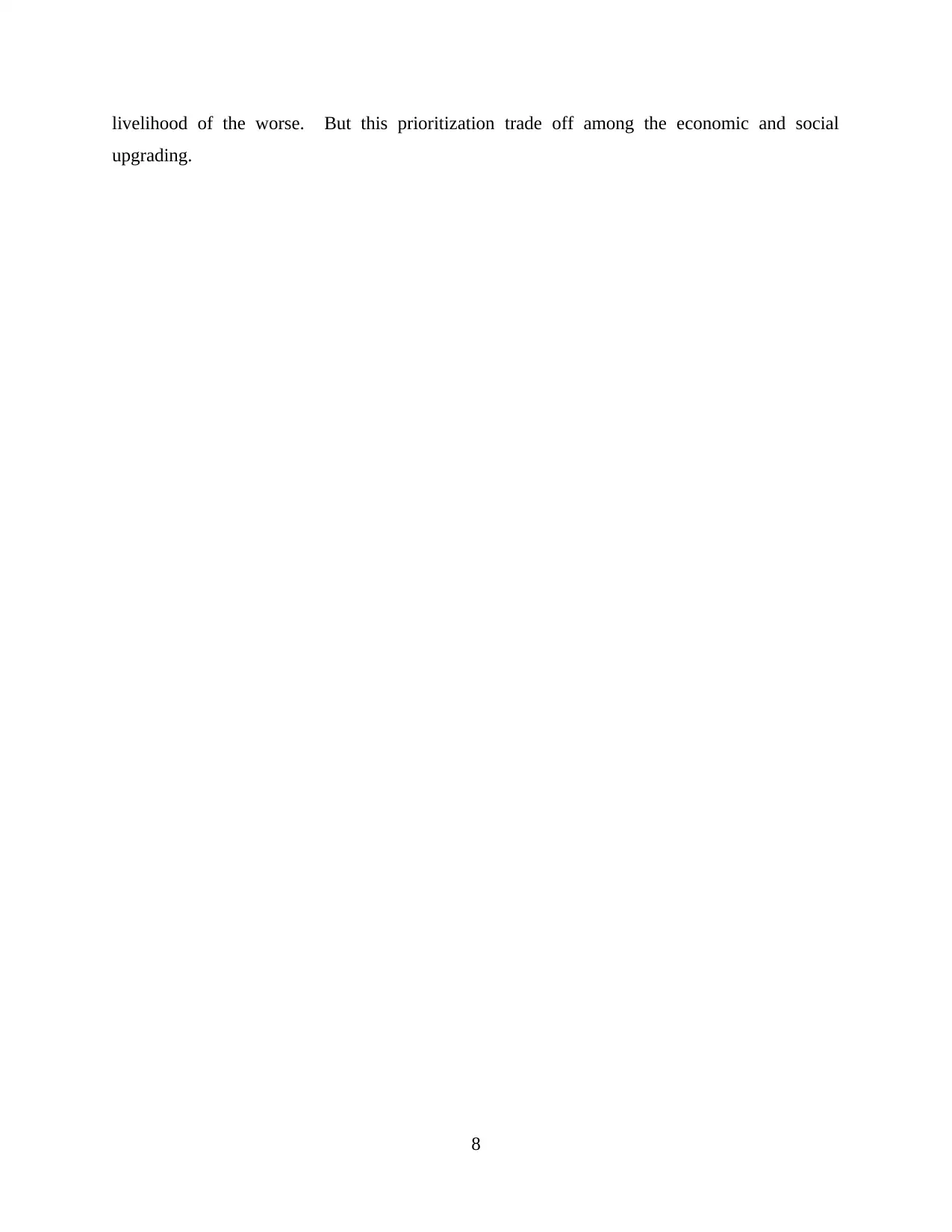
livelihood of the worse. But this prioritization trade off among the economic and social
upgrading.
8
upgrading.
8
Paraphrase This Document
Need a fresh take? Get an instant paraphrase of this document with our AI Paraphraser
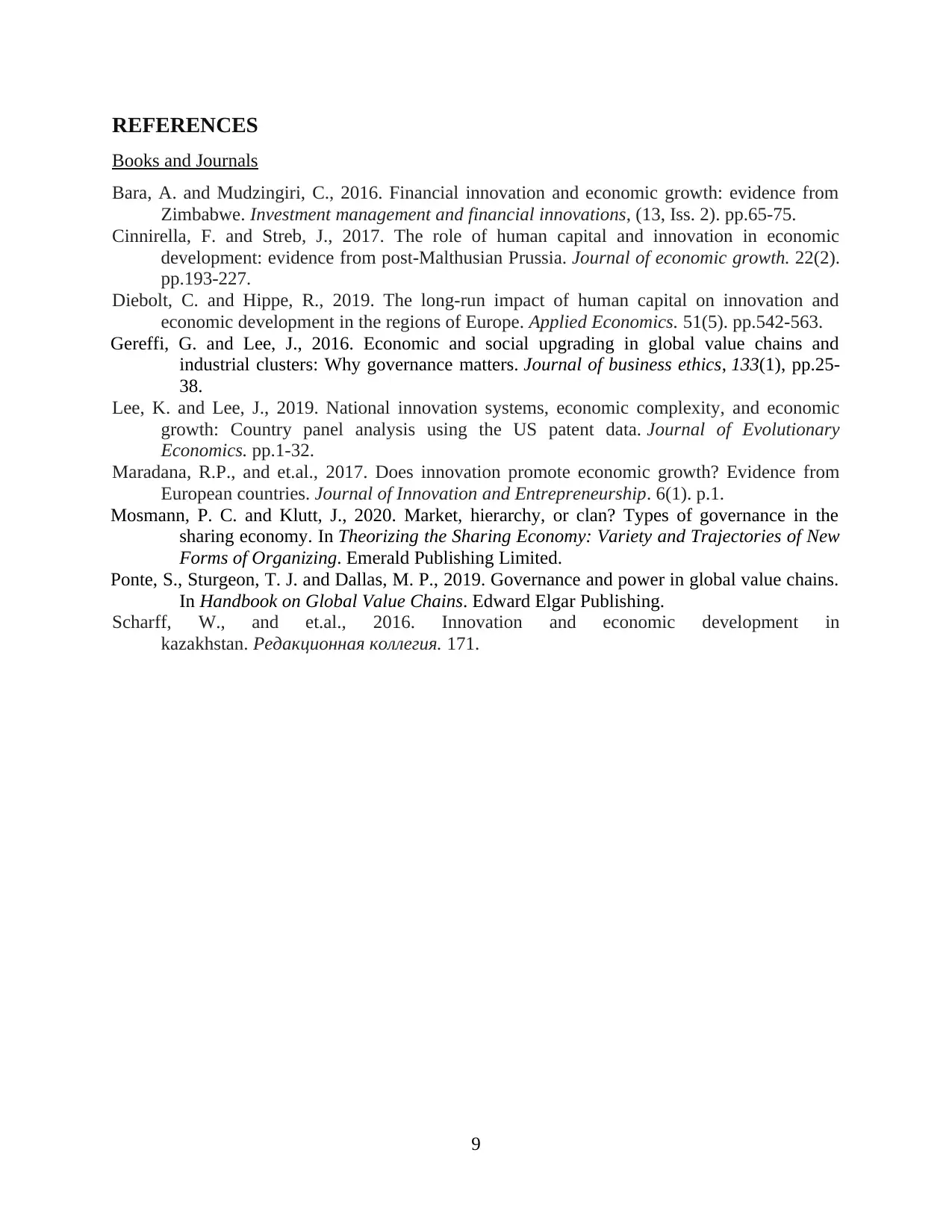
REFERENCES
Books and Journals
Bara, A. and Mudzingiri, C., 2016. Financial innovation and economic growth: evidence from
Zimbabwe. Investment management and financial innovations, (13, Iss. 2). pp.65-75.
Cinnirella, F. and Streb, J., 2017. The role of human capital and innovation in economic
development: evidence from post-Malthusian Prussia. Journal of economic growth. 22(2).
pp.193-227.
Diebolt, C. and Hippe, R., 2019. The long-run impact of human capital on innovation and
economic development in the regions of Europe. Applied Economics. 51(5). pp.542-563.
Gereffi, G. and Lee, J., 2016. Economic and social upgrading in global value chains and
industrial clusters: Why governance matters. Journal of business ethics, 133(1), pp.25-
38.
Lee, K. and Lee, J., 2019. National innovation systems, economic complexity, and economic
growth: Country panel analysis using the US patent data. Journal of Evolutionary
Economics. pp.1-32.
Maradana, R.P., and et.al., 2017. Does innovation promote economic growth? Evidence from
European countries. Journal of Innovation and Entrepreneurship. 6(1). p.1.
Mosmann, P. C. and Klutt, J., 2020. Market, hierarchy, or clan? Types of governance in the
sharing economy. In Theorizing the Sharing Economy: Variety and Trajectories of New
Forms of Organizing. Emerald Publishing Limited.
Ponte, S., Sturgeon, T. J. and Dallas, M. P., 2019. Governance and power in global value chains.
In Handbook on Global Value Chains. Edward Elgar Publishing.
Scharff, W., and et.al., 2016. Innovation and economic development in
kazakhstan. Редакционная коллегия. 171.
9
Books and Journals
Bara, A. and Mudzingiri, C., 2016. Financial innovation and economic growth: evidence from
Zimbabwe. Investment management and financial innovations, (13, Iss. 2). pp.65-75.
Cinnirella, F. and Streb, J., 2017. The role of human capital and innovation in economic
development: evidence from post-Malthusian Prussia. Journal of economic growth. 22(2).
pp.193-227.
Diebolt, C. and Hippe, R., 2019. The long-run impact of human capital on innovation and
economic development in the regions of Europe. Applied Economics. 51(5). pp.542-563.
Gereffi, G. and Lee, J., 2016. Economic and social upgrading in global value chains and
industrial clusters: Why governance matters. Journal of business ethics, 133(1), pp.25-
38.
Lee, K. and Lee, J., 2019. National innovation systems, economic complexity, and economic
growth: Country panel analysis using the US patent data. Journal of Evolutionary
Economics. pp.1-32.
Maradana, R.P., and et.al., 2017. Does innovation promote economic growth? Evidence from
European countries. Journal of Innovation and Entrepreneurship. 6(1). p.1.
Mosmann, P. C. and Klutt, J., 2020. Market, hierarchy, or clan? Types of governance in the
sharing economy. In Theorizing the Sharing Economy: Variety and Trajectories of New
Forms of Organizing. Emerald Publishing Limited.
Ponte, S., Sturgeon, T. J. and Dallas, M. P., 2019. Governance and power in global value chains.
In Handbook on Global Value Chains. Edward Elgar Publishing.
Scharff, W., and et.al., 2016. Innovation and economic development in
kazakhstan. Редакционная коллегия. 171.
9
1 out of 11
Related Documents
Your All-in-One AI-Powered Toolkit for Academic Success.
+13062052269
info@desklib.com
Available 24*7 on WhatsApp / Email
![[object Object]](/_next/static/media/star-bottom.7253800d.svg)
Unlock your academic potential
Copyright © 2020–2025 A2Z Services. All Rights Reserved. Developed and managed by ZUCOL.





